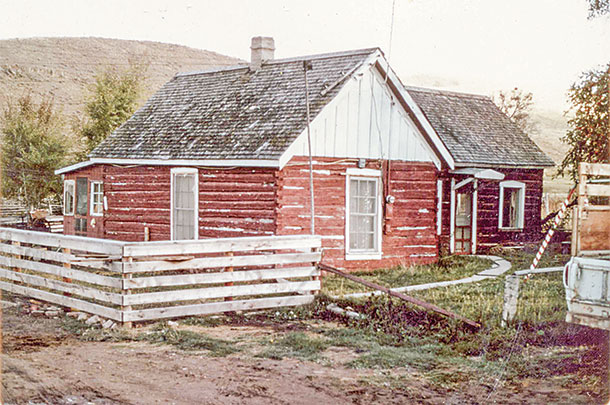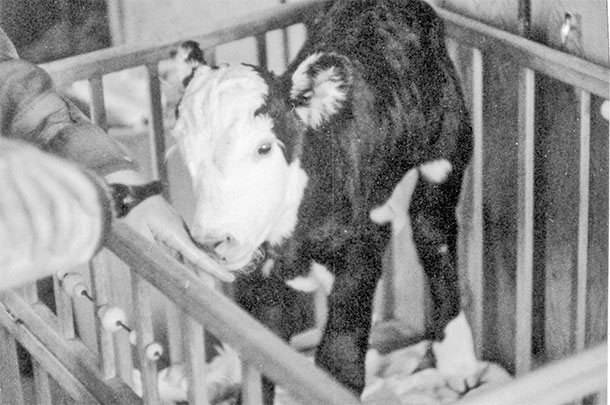The first one that came into our house was a little Hereford heifer we named Merry Christmas Muggins (Merry Muggins for short) a couple years after my husband and I were married.
We’d bought a group of purebred Hereford cows at a reduction sale at the nearby Pine Creek Ranch (owned by our good friends Emmett and Eleanor Reese), and some of those cows were bred to calve early. One young cow, which we’d nicknamed Grendel, started calving the afternoon before Christmas.
We were going to have a Christmas Eve baby. So we put Grendel in the pen next to our front yard, where we could watch her from the window and make sure everything went OK.
By the time she actually calved, it was nearly dark. The temperature was swiftly dropping. The little wet calf would soon have frozen ears and tail.
So my husband, Lynn, carried the calf into the house where we could dry her with towels in the kitchen next to the wood stove. Her mama was very upset about our calf snatching and tried to follow Lynn out the gate. I slammed the gate in her face and helped Lynn get the calf into the house.
Grendel watched us from the calving pen and then stood looking toward the living-room window, where she could see our activity within since the kitchen was merely an extension of the living room. I watched the angry, upset mama pacing the fence as I vigorously rubbed her baby with towels.

At that time, our yard fence was not very tall – when we moved here in 1967 it was more decorative than functional. The next thing I knew, Grendel had jumped over the fence and was peering in the window, preparing to crash through it and come get her calf.
I yelled at Lynn and we both ran outside to head her off before we had a huge unwanted visitor. I hate to imagine the chaos she’d have created if she’d come into the house.
We moved Grendel into another pen, finished drying Merry Muggins and took baby back out to mama. We then finished our Christmas Eve preparations, hung a Christmas stocking for our young son – and were thankful that we still had a living room and a Christmas tree and were not cleaning up after an angry cow.
In comes Rudolph
The next memorable Christmas calf was one who lived in our house for several weeks in 1976. He was born prematurely and was too small and frail to live outdoors.
That December, our cows were still grazing our 320-acre mountain pasture. We hadn’t brought them down to the main ranch yet for calving. The first calves were due in early January. For more than 30 years we calved in January to have the cows bred again before they went to summer BLM range in May.
Selecting a calving season is a dilemma for ranchers who have to use public range. If you calve in late spring or early summer, the cows are up in the mountains and more difficult to check on, with more risk for problems – and predators killing the baby calves.
It’s also difficult to get the cows re-bred in a timely fashion in that big, steep country; it takes more bulls and usually results in a more strung-out calving because the bulls don’t always find all the cows. We calved in January in order to have the cows all bred in April, at home, to our own bulls.
With the cows due to start calving the first week in January, more than a few years we had early arrivals in late December or even on Christmas. But the calf who lived in our house over Christmas was born just before we brought the cows down from the 320-acre mountain pasture.
I found him when I rode up to the far corner to start gathering cows on the snow-covered hillside above the timbered creek. A big coyote was watching him, but mama was watching the coyote.
The calf had managed to get up, and mama had licked him dry, but he was so tiny he could walk right under her belly. I thought about trying to put him over my saddle to get him down out of the mountains, but the young horse I was riding was not ready for such a novel passenger.
I chased the coyote away and rode to the other side of the mountain to find Lynn, who was driving the jeep and calling the cows down off the hillsides on that part of the pasture.
I told him about the calf, so he drove over to Baker Creek and as far as he could up the little creek, then hiked the rest of the way up the canyon and carried the calf down to the jeep.
The kids were home from school by the time we brought the cows down, and they named the calf Rudolph because of his red frostbitten nose. Rudolph was chilled and showing signs of pneumonia, so he had to stay indoors. He lived in our daughter’s old crib in the kitchen for several weeks, fed with a bottle.

By Christmas time, he was healthy and lively, and we let him out of the crib several times a day for exercise. He loved running and bucking around the living room and trying to butt heads with the kids.
He especially liked the Christmas tree and was fascinated by the shiny ornaments; we had to make sure he didn’t get too close and personal with the tree.
It was a fun Christmas, with Rudolph helping us enjoy it. We’ve had other calves in the house at Christmas time (including a premature calf the kids named Boom Boom – who also enjoyed bucking around in our living room), but Rudolph was probably the most memorable.
He became a pet, raised on a bottle, and the kids were sad to see him go outdoors when he finally became “full-term” size in mid-January.
A ‘Quicksie’ New Year
We had plenty of New Year’s babies as well – but the one I remember most was Quicksie’s calf, who kept us home from a nice dinner. We hadn’t started calving yet, and some friends had invited us to their home for New Year’s Eve.
We were just about to leave when Lynn made one last hike with a flashlight through the soon-to-be-calving cows in the field below our house. He discovered that Quicksie had calved down by the creek on the ice – and her new baby was freezing.
So we called our friends to tell them we couldn’t make it to dinner and spent New Year’s Eve drying that calf in the house instead of eating roast goose.
I guess our cattle always came first; they own us rather than the other way around. But it’s been a great life, and I am thankful for having had the opportunity to be a caretaker of cows. They have been a part of our lives every day, including Christmas, and our lives have been the richer for these experiences. ![]()
Heather Thomas is the author of Cow Tales: More True stories from an Idaho Ranch and Ranch Tales: Stories of Dogs, Cats & Other Crazy Critters. Her writings are available on amazon.com and you can contact her directly to autograph copies.
PHOTO 1: The calf bouncing around the living room is Boom Boom, a premature calf like those mentioned by the author in previous years.
PHOTO 2: The log homestead cabin we moved into didn’t have much fence around the front yard when Grendel jumped over it.
PHOTO 3: Rudolph, a premature calf raised for a short time in the family crib. Photos provided by Heather Smith Thomas.








